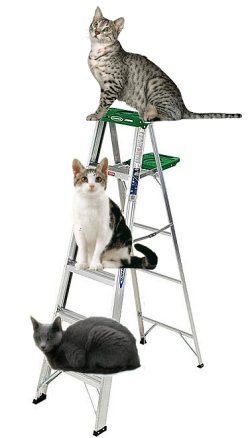Top Cat: The Feline Hierarchy in multicat households.

Cat hierarchy plays an important part in how cats in a multicat family get along with each other. Of course if you have just one cat, that cat will be the boss cat. It is not difficult to be number one when there's no number two. However, if you add another cat to the family, the first cat will not necessary remain be top cat. Any further additions to the family will, by definition, force shake things up even more, because the new cat will have to find its own rank in the pecking (and clawing, scratching and biting) order.
When thinking of a multicat family, one has to remember that cats are not as socially easy-going as dogs. Cats are territorial and most cats will fiercely defend their own territory. The territory of a free-roaming cat may be very large, especially with tomcats (more about cat territory can be found in our earlier article). This territory shrinks in the urban areas because space is limited and food is abundant. Indoor multicat families don't need to compete for food, since the food is plentiful, so an individual's territory can be downsized even further, but make no mistake, there is a certain core territory which each cat needs to claim for itself. That could be an individual chair, a particular branch of the cat tree, or an area under the bed.
A human may fondly imagine that all the cats the household are equals. After all you love each of them just as much, so it stands to reason that all the cats should get on as a happy, friendly family, doesn't it? Unfortunately no. Although some cats may become firm friends, most are prepared to go only as far as tolerating each other.
So how can a human decipher the subtle relationships and hierarchy among the cats in the family? Actually it is not that hard. Cats like to get high and look down at everything going on around (or preferably below). In most cases the top cat is literally that - the cat occupying the highest available spot. From time to time they may permit cats from the lower ranks to take the prime position, but only on the understanding that the spot will be yielded as soon as top cat wants it. Another clue as to the status of the cats can be obtained by watching how they enter the room. High-rankers cats will go straight to the middle, whereas a cat lower in hierarchy, will likely slink round by the wall. Other noticeable thing is posture and eye contact. For example, most cats first posture or engage in an eyeballing contest before getting into a fight. Cats close in status are more likely to actually get physical.
Is the top cat the biggest and most aggressive?
Not necessarily. Being large and muscular does help a prospective candidate, but often a cat with the greatest calmness and self-assurance claims on the hierarchy ladder. A timid and anxiety-prone cat is doomed to lower status. Timid cats may actually prefer that since with the status often comes responsibility. In one case there was a multicat household where all cats had unrestricted outdoor access. Once the cats were outside, neighbourhood cats would never enter the property. The top cat was always at his favourite spot serenely watching the world go by. When this cat died, there was a drastic and visible change. Because the group now lacked a cat which could fiollow in the pawsteps of that top cat the group became slightly dysfunctional, and neighbourhood cats picked upon this almost instantaneously. As a result the previously peaceful cat family constantly spent its time in running battles with outside cats trying to claim the new territory.
Status in a cat hierarchy depends not only on size of the cat, but also its age and sexual and social maturity. The latter two, incidentally, are not the same. Cats reach sexual maturity at between six and nine months, but it takes a good couple of years to become socially mature. Another factor is health. A top cat that becomes ill is quickly demoted (which is one reason why cats are very good at hiding disabilities).
The cat hierarchy is continuously shifting and adjusting. Big events such as the addition of a new cat or house-moving may cause considerable disruption, and a previously peaceful home becomes a house full of fighting and hissing as new territorial pacts are hammered out. But there does not need to be a big change for a stable hierarchy to be disrupted. Let say it is summer and a top cat has a nice spot at the top of the cat tree overlooking the garden. During this time a lower ranking cat may choose a chair close to the fire place. Come winter, it is cold and dark outside, and the chair next to the fire has become prime real estate. So the top cat muscles the lower ranker from that spot, leaving the previous occupant temporarily without a core territory. This is bad news for the next cat down in the heirarchy, and so on down until a new equilibrium is reached - until spring.
